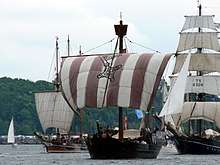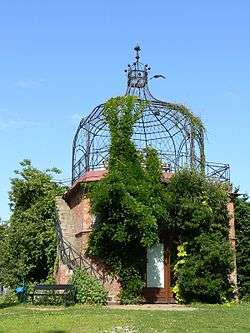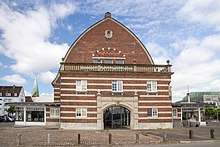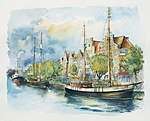Kiel
Kiel (German: [kiːl] (![]()
Kiel | |
|---|---|
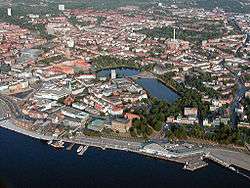 Mid-August 2003 aerial view of the city centre | |
 Flag  Coat of arms | |
Location of Kiel 
| |
 Kiel  Kiel | |
| Coordinates: 54°19′24″N 10°08′22″E | |
| Country | Germany |
| State | Schleswig-Holstein |
| District | Urban district |
| Subdivisions | 18 districts |
| Government | |
| • Lord Mayor | Ulf Kämpfer[1] |
| • Governing parties | SPD / Greens / South Schleswig Voter Federation |
| Area | |
| • City | 118.6 km2 (45.8 sq mi) |
| Elevation | 5 m (16 ft) |
| Population (2018-12-31)[2] | |
| • City | 247,548 |
| • Density | 2,100/km2 (5,400/sq mi) |
| • Metro | 643,594[3] |
| Time zone | CET/CEST (UTC+1/+2) |
| Postal codes | 24103–24159 |
| Dialling codes | 0431 |
| Vehicle registration | KI |
| Website | www.kiel.de |
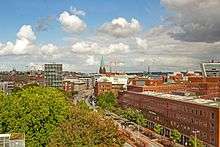
Kiel lies approximately 90 kilometres (56 mi) north of Hamburg. Due to its geographic location in the north of Germany, the southeast of the Jutland peninsula and the southwestern shore of the Baltic Sea, Kiel has become one of the major maritime centres of Germany. For instance, the city is known for a variety of international sailing events, including the annual Kiel Week, which is the biggest sailing event in the world. Kiel is also known within modern history for the Kiel Mutiny, where German sailors refused to board Navy vessels in protest against Germany's continued fighting in World War I which led to the abdication of the Kaiser and the formation of the Weimar Republic. The Olympic sailing competitions of the 1936 and the 1972 Summer Olympics were held in the Bay of Kiel.[4]
Kiel has also been one of the traditional homes of the German Navy's Baltic fleet, and continues to be a major high-tech shipbuilding centre. Located in Kiel is the GEOMAR - Helmholtz Centre for Ocean Research Kiel at the University of Kiel. Kiel is an important sea transport hub, thanks to its location on the Kiel Fjord (Kieler Förde) and the busiest artificial waterway in the world, Kiel Canal (Nord-Ostsee-Kanal). A number of passenger ferries to Sweden, Norway, Lithuania and other countries operate from here. Moreover, today Port of Kiel is a popular desination for cruise ships touring the Baltic Sea.
Kiel's recorded history began in the 13th century, but the city was originally a Danish village, in the 8th century. Until 1864 it was administered by Denmark in personal union. In 1866 the city was annexed by Prussia and in 1871 it became part of Germany.
Kiel was one of the founding cities of original European Green Regi51 Award in 2006.[5] In 2005 Kiel's GDP per capita was €35,618, which is well above Germany's national average, and 159% of the European Union's average.[6]
History
Middle Ages
Kiel Fjord and the village of Kiel was probably the last settled by Vikings who wanted to colonise the land that they had raided, and for many years they settled in German villages. This is evidenced by the geography and architecture of the fjord. The city of Kiel was founded in 1233 as Holstenstadt tom Kyle by Count Adolf IV of Holstein, and granted Lübeck city rights in 1242 by Adolf's eldest son, John I of Schauenburg. Being a part of Holstein, Kiel belonged to the Holy Roman Empire and was situated only a few kilometres south of the Danish border.[7]

Kiel, the capital of the county (later duchy) of Holstein, was a member of the Hanseatic League from 1284 until it was expelled in 1518 for harbouring pirates. In 1431, the Kieler Umschlag (trade fair) was first held, which became the central market for goods and money in Schleswig-Holstein, until it began to lose significance from 1850 on, being held for the last time in 1900, until recently, when it has been restarted.
Modern times
The University of Kiel was founded on 29 September 1665 by Christian Albert, Duke of Holstein-Gottorp. A number of important scholars, including Theodor Mommsen, Felix Jacoby, Hans Geiger and Max Planck, studied or taught there.
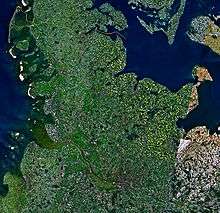

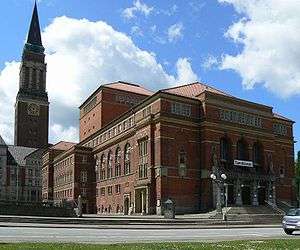
From 1773 to 1864, the town belonged to the king of Denmark. However, because the king ruled Holstein as a fief of the Holy Roman Empire only through a personal union, the town was not incorporated as part of Denmark proper. Thus Kiel belonged to Germany, but it was ruled by the Danish king. Even though the empire was abolished in 1806, the Danish king continued to rule Kiel only through his position as Duke of Holstein, which became a member of the German Confederation in 1815. When Schleswig and Holstein rebelled against Denmark in 1848 (the First Schleswig War), Kiel became the capital of Schleswig-Holstein until the Danish victory in 1850.
During the Second Schleswig War in 1864, Kiel and the rest of the duchies of Schleswig and Holstein were conquered by a German Confederation alliance of the Austrian Empire and the Kingdom of Prussia. After the war, Kiel was briefly administered by both the Austrians and the Prussians, but the Austro-Prussian War in 1866 led to the formation of the Province of Schleswig-Holstein and the annexation of Kiel by Prussia in 1867. On 24 March 1865 King William I based Prussia's Baltic Sea fleet in Kiel instead of Danzig (Gdańsk). The Imperial shipyard Kiel was established in 1867 in the town.
When William I of Prussia became Emperor William I of the German Empire in 1871, he designated Kiel and Wilhelmshaven as Reichskriegshäfen ("Imperial War Harbours"). The prestigious Kiel Yacht Club was established in 1887 with Prince Henry of Prussia as its patron. Emperor Wilhelm II became its commodore in 1891.
Because of its new role as Germany's main naval base, Kiel very quickly increased in size in the following years, from 18,770 in 1864 to about 200,000 in 1910. Much of the old town centre and other surroundings were levelled and redeveloped to provide for the growing city. The Kiel tramway network, opened in 1881, had been enlarged to 10 lines, with a total route length of 40 km (25 mi), before the end of the First World War.
Kiel was the site of the sailors' mutiny which sparked the German Revolution in late 1918. Just before the end of the First World War, the German fleet stationed at Kiel was ordered to be sent out on a last great battle with the Royal Navy. The sailors, who thought of this as a suicide mission which would have no effect on the outcome of the war, decided they had nothing to lose and refused to leave the safety of the port. The sailors' actions and the lack of response of the government to them, fuelled by an increasingly critical view of the Kaiser, sparked a revolution which caused the abolition of the monarchy and the creation of the Weimar Republic.

During the Second World War, Kiel remained one of the major naval bases and shipbuilding centres of the German Reich. There was also a slave labour camp for the local industry.[8] Because of its status as a naval port and as production site for submarines, Kiel was heavily bombed by the Allies during this period. The bombing destroyed more than 80% of the remaining old town, 72% of the central residential areas, and 83% of the industrial areas.[9] During the RAF bombing of 23/24 July 1944, Luftwaffe fighters tried to intercept the spoof (i.e. decoy) force instead of the main force attacking Kiel,[10] and there was no water for three days; trains and buses did not run for eight days and there was no gas available for cooking for three weeks.[11] There were several bombing raids of the port area during the period 20 February – 20 April 1945 which successfully eliminated many U-Boats, and the few large warships (cruisers Hipper, Scheer, and Köln) still afloat at that time. Although the town was beyond the stop-line set for the western Allies in the German surrender at Lüneburg Heath, it and its port, its scientists, and the canal were seized by a British T-Force led by Major Tony Hibbert on 5 May 1945.[12][13] This forestalled capture of the town by the Soviets, whom the Allies expected to advance from Germany to Denmark in violation of the Yalta agreement.[14]
Like other heavily bombed German cities, the city was rebuilt after the war. In 1946, Kiel was named the seat of government for Schleswig-Holstein, and it officially became the state's capital in 1952.
Today, Kiel is once again an important maritime centre of Germany, with high-tech shipbuilding, submarine construction and one of the three leading institutions in the field of marine sciences in Europe, the IFM-GEOMAR. Regular ferries to Scandinavia and Lithuania, as well as the largest sailing event in the world called the Kiel Week (Kieler Woche) in German and The Kiel Regatta in English. The Kieler Umschlag is another festival, which has been taking place again since 1975. Kiel is also home to a large service sector and a number of research institutions including the University of Kiel, which is the oldest, largest, and most prestigious university in the state.
Geography
Climate
Kiel has an oceanic climate (Cfb in the Köppen climate classification).
| Climate data for Kiel | |||||||||||||
|---|---|---|---|---|---|---|---|---|---|---|---|---|---|
| Month | Jan | Feb | Mar | Apr | May | Jun | Jul | Aug | Sep | Oct | Nov | Dec | Year |
| Record high °C (°F) | 13.4 (56.1) |
16.0 (60.8) |
21.4 (70.5) |
29.3 (84.7) |
33.5 (92.3) |
34.4 (93.9) |
34.2 (93.6) |
35.0 (95.0) |
30.1 (86.2) |
25.2 (77.4) |
19.5 (67.1) |
14.8 (58.6) |
35.0 (95.0) |
| Average high °C (°F) | 2 (36) |
3 (37) |
6 (43) |
11 (52) |
16 (61) |
20 (68) |
21 (70) |
21 (70) |
18 (64) |
13 (55) |
8 (46) |
4 (39) |
12 (53) |
| Daily mean °C (°F) | 0.7 (33.3) |
1.0 (33.8) |
3.3 (37.9) |
6.7 (44.1) |
11.5 (52.7) |
15.1 (59.2) |
16.3 (61.3) |
16.3 (61.3) |
13.3 (55.9) |
9.7 (49.5) |
5.3 (41.5) |
2.1 (35.8) |
8.4 (47.2) |
| Average low °C (°F) | −2 (28) |
−2 (28) |
0 (32) |
3 (37) |
7 (45) |
11 (52) |
12 (54) |
12 (54) |
10 (50) |
7 (45) |
3 (37) |
0 (32) |
5 (41) |
| Record low °C (°F) | −20.8 (−5.4) |
−24.8 (−12.6) |
−14.5 (5.9) |
−6.9 (19.6) |
−3.0 (26.6) |
1.6 (34.9) |
4.3 (39.7) |
4.7 (40.5) |
0.6 (33.1) |
−6.2 (20.8) |
−12.0 (10.4) |
−15.1 (4.8) |
−24.8 (−12.6) |
| Average rainfall mm (inches) | 65 (2.6) |
40 (1.6) |
54 (2.1) |
52 (2.0) |
57 (2.2) |
69 (2.7) |
79 (3.1) |
69 (2.7) |
66 (2.6) |
67 (2.6) |
86 (3.4) |
74 (2.9) |
778 (30.5) |
| Average rainy days (≥ 1.0 mm) | 18 | 15 | 13 | 14 | 12 | 14 | 15 | 16 | 15 | 17 | 18 | 18 | 185 |
| Average relative humidity (%) | 87 | 84 | 81 | 77 | 74 | 74 | 76 | 78 | 81 | 85 | 86 | 87 | 81 |
| Mean monthly sunshine hours | 38.5 | 64.4 | 106.4 | 171.1 | 230.2 | 237.1 | 218.7 | 220.4 | 150.5 | 102.3 | 52.0 | 34.9 | 1,626.5 |
| Source: DWD; wetterkontor.de; ; | |||||||||||||
Districts

| Year | Pop. | ±% |
|---|---|---|
| 1300 | 1,000 | — |
| 1450 | 2,000 | +100.0% |
| 1682 | 3,310 | +65.5% |
| 1750 | 4,500 | +36.0% |
| 1871 | 31,764 | +605.9% |
| 1900 | 107,977 | +239.9% |
| 1919 | 205,330 | +90.2% |
| 1925 | 213,587 | +4.0% |
| 1933 | 218,335 | +2.2% |
| 1939 | 273,735 | +25.4% |
| 1950 | 254,449 | −7.0% |
| 1961 | 273,284 | +7.4% |
| 1970 | 271,719 | −0.6% |
| 1987 | 237,767 | −12.5% |
| 2011 | 235,782 | −0.8% |
| 2018 | 248,548 | +5.4% |
| source:[15] | ||
The city districts of Düsternbrook, Schreventeich, Ravensberg and Blücherplatz are popular places to live with many 19th century buildings, villas and tree-lined streets. The government offices, ministries and parliament of the state of Schleswig-Holstein are also mainly based in these neighbourhoods, particularly Düsternbrook. In contrast to the heavy bomb damage inflicted on the central parts of the city during the Second World War, most of the residential areas were not severely damaged. Hence, Kiel's more modern-style inner city and Kiel's more historic/elaborate residential areas stand in architectural contrast to one another.
There are plans for large-scale improvement and building efforts for the inner city, providing better pavements, better access to and view of the waterfront, and a generally more attractive feel to the place. These plans, most notably the "Kleiner Kiel Kanal", a restoration of a historic canal that was filled in to make place for road infrastructure, are to be implemented in the next few years.[16]
The largest groups of foreign residents by 31.12.2018 are listed below :
| 4,710 | |
| 4,410 | |
| 2,240 | |
| 2,095 | |
| 1,255 | |
| 985 | |
| 775 | |
| 595 | |
| 520 | |
| 505 | |
Main sights

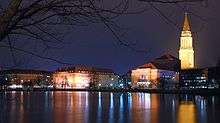
The oldest building in the city is the 13th century Church of St. Nicholas, which has a sculpture by Ernst Barlach in front of it called Geistkämpfer.
Kiel is Schleswig-Holstein's largest city, and therefore Kiel's shopping district is a major attraction, and will see further improvement and renovation efforts in the upcoming years. Kiel's Holstenstraße (Holsten Street) is one of the longest shopping streets in Germany. The Rathaus (Town Hall), which was built in 1911, has an operating paternoster lift and the design of its tower was based on one in Venice. The square in front of it is bordered by a lake and the Opernhaus Kiel (KIel Opera House). There are also a number of lakes and parks in the city centre, such as Schrevenpark. There are two botanical gardens, the Old Botanical Garden and the Botanischer Garten der Christian-Albrechts-Universität zu Kiel (or New Botanical Garden).
As Kiel is situated near the sea, the beaches to the north of Kiel, such as Strande, Kiel-Schilksee, Möltenort and Laboe, are also popular places to visit in spring and summer.
Kiel Week, also known in English as the Kiel Regatta, is the largest sailing event in the world and takes place every year in the last full week in June. Many thousands of boats and ships of all kinds and eras take part in the parade. Kiel Week is also a festival, Volksfest and fair as well as a maritime event. There are a number of yachting and sailing clubs in picturesque settings.
Kiel also features a number of museums, including zoological, geological, historical, fine art, industrial and military museums. Notable is the Stadt- und Schifffahrtsmuseum Warleberger Hof (City and Maritime Museum), which belongs to the association museen am meer. In addition to preserving architecture from the 16th century and historic rooms with painted stucco ceilings, it displays urban and cultural exhibits of the 19th and 20th centuries.[17] Particularly intriguing is the history of the carnival in Kiel.[17] The Schifffahrtsmuseum is in the former fish market building in the harbour.
Laboe is home to the Laboe Naval Memorial and the Second World War submarine U-995, which are both popular tourist sites.
Culture
Sports
There are a number of sports venues in Kiel, most notably the Sparkassen-Arena (formerly known as Baltic Sea Hall or Ostseehalle), which is the home ground of one of the most successful team handball clubs in the world and multiple German champion, THW Kiel. There is currently no Bundesliga football club in Kiel, but 2. Bundesliga side Holstein Kiel plays at Holstein-Stadion.
Education and scientific research
The University of Kiel (German: Christian-Albrechts-Universität), which was founded by Duke Christian Albrecht in 1665, is with round about 25.000 students the only full university of Schleswig-Holstein. Independent, but partly linked to the University Kiel are other research facilities such as the German National Library of Economics – Leibniz Informationcenter for Economy, the Kiel Institute for the World Economy, the GEOMAR Helmholtz Centre for Ocean Research Kiel and the research institute of the Bundeswehr for water sound and geophysics. Besides these there are other educational institutions such as the Fachhochschule Kiel (founded in 1969) and the Muthesius School of Arts (founded in 1907). The projects Murmann School of Global Management and Economics and Multimedia Campus Kiel weren't successful at last. The Wirtschaftsakademie Schleswig-Holstein offers besides advanced training at the Berfusakademie dual study courses for economists, business information specialists and industrial engineers.
Noteworthy as departmental research institute is the federal institute for dairy research which was merged into the Max-Rubner-Institut together with other institutions in 2004. The state capital Kiel is a corporative sponsoring member of the Max Planck Society.[18]
The ARGE-SH as eldest building research institution of the republic of Germany has its headquarters in Kiel.
There are twelve Gymnasiums in Kiel, of which the Kieler Gelehrtenschule, founded in 1320 as a humanistic gymnasium, is the oldest. Other secondary schools are amongst others the Gymnasium Elmschenhagen and the Max-Planck-Schule with a focus on natural sciences. Furthermore, there are many comprehensive schools – partially with secondary schools – all over the city area and private schools, too.
Economy and infrastructure
Kiel's economy is dominated by the service sector, transport and maritime industries. Kiel is also one of the major ports of the German Navy, and a leading centre of German high-tech military and civil shipbuilding. Kiel is the home of Howaldtswerke-Deutsche Werft, a shipyard founded in 1838 famed for its construction of submarines. HDW built the first German submarine Brandtaucher in 1850, and is today a subsidiary of ThyssenKrupp Marine Systems, the leading German group of shipyards.
Statistics
In 2005, the GDP per person was €35,618, which is well above the national average of Germany and 159% of the European Union average.[6]
| 2005 EUROSTAT[19] | Nominal GDP per capita |
|---|---|
| €35,618 | |
| €24,250 | |
| €27,219 | |
| €22,400 |
Notable companies
Some of the most notable companies having branches or their headquarters in Kiel are:
Ferry operators
Military contractors
- Raytheon
- Rheinmetall
- ThyssenKrupp Marine Systems (through their subsidiary Howaldtswerke-Deutsche Werft)
Engineering and industrial machinery
- Heidelberger Druckmaschinen
- Voith
- Vossloh
- Caterpillar Inc. (through their subsidiary MaK)
Others
- LaserSoft Imaging
- Schenker AG
- HSH Nordbank
Kiel is also home to several insurances and banks, most notably the HSH Nordbank, Provinzial NordWest, Förde Sparkasse, Kieler Volksbank eG and Evangelischen Bank eG.
There is also an active startup scene in Kiel with startup accelerator StarterKitchen and startups like SciEngines GmbH, Real-Eyes, myBoo, SealMedia, Cliplister, Druckpreis.DE, promotionbasis.de, Yoosello, GetAnEdge, Flowy Apps, fraguru, lokalportal, PianoMotion and ubique art.[20][21][22][23][24][25][26][27][28]
Kiel is home to several media companies, including a branch of the Norddeutscher Rundfunk producing one radio channel and several local programmes in Kiel, a station of the British Forces Broadcasting Service, the daily newspaper Kieler Nachrichten and several smaller local radio channels and magazines.
Transport

Kiel is situated near an important pan-European motorway, the A7, which connects northern Europe with central and southern Europe.
The central railway station, Kiel Hauptbahnhof, has hourly trains to Hamburg, Lübeck, Flensburg, and Husum. The Intercity Express (ICE) connects Kiel with Berlin, Frankfurt, Cologne and Munich. There are 8 regional railway stations within the city proper,[29][30] which are connected with each other, the main railway station Kiel Hbf and other stations by regional trains, which can be used within the boundaries of the city with a normal bus ticket.[31]
The city's bus service is provided by local company KVG. Autokraft and Verkehrsbetriebe Kreis Plön providing regional bus service, and the Schlepp- und Fährgesellschaft Kiel provides public transport on the fjord with ferries.
The Port of Kiel is a significant port for passenger and cargo shipping from Germany to Scandinavia, the Baltic States and Russia. Passenger ferries operate to and from Gothenburg in Sweden (Stena Line, 131⁄2 hours, daily), Oslo in Norway (Color Line, 191⁄2 hours, daily), and Klaipėda in Lithuania (DFDS Lisco, 21 hours, 6 times per week). Cargo ferries operate from and to Saint Petersburg in Russia (DFDS Lisco, twice a week), and Kaliningrad in Russia (NSA, once a week).
The nearest international airport is Hamburg Airport, which is situated approximately 90 kilometres (56 mi) to the south of Kiel. There is a shuttle bus service (KIELIUS) operating between Hamburg Airport and Kiel central railway station. There is also an airport at Lübeck.
Notable people




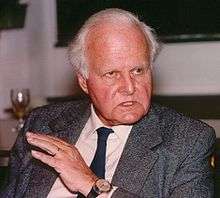
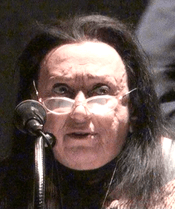
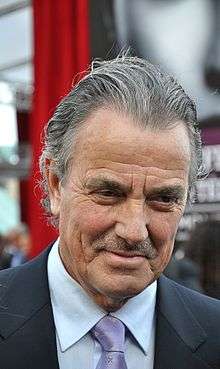


Up to 1800
- Peter III of Russia (1728–1762) emperor of Russia[32] for six months in 1762
- Johannes Nikolaus Tetens (1736–1807), German-Danish philosopher and statistician
- Karl Leonhard Reinhold (1757–1823), an Austrian philosopher[33]
- Johan Ludwig Gebhard Lund (1777–1867), Danish painter, adherent of romanticism, known for his history paintings
- Carl Loewe (1796–1869), German composer,[34] tenor singer and conductor
- Gustav Adolf Michaelis (1798–1848), obstetrician and physician
1800 to 1850
- August Howaldt (1809–1889), founder of Howaldtswerke
- Friedrich Wilhelm Hermann Delffs (1812–1894), chemist
- Henri Lehmann (1814–1882), German-born French historical painter and portraitist
- Adolf Michaelis (1835–1910) German classical scholar, a professor of art history
- Robert Michaelis von Olshausen (1835–1915) German obstetrician[35] and gynecologist
- August Mau (1840–1909) German art historian and archaeologist
- August Leskien (1840–1916), German linguist,[36] active in comparative linguistics
- Detlev von Liliencron (1844–1909), German lyric poet[37] and novelist
- Hermann Graedener (1844–1929) German composer, conductor and teacher
1850 to 1900
- Ferdinand Tönnies (1855–1936), sociologist, philosopher
- Kuno Francke (1855–1930), was a US educator and historian at Harvard University
- Friedrich Ferdinand of Schleswig-Holstein-Sonderburg-Glücksburg (1855–1934) was the fourth Duke of Schleswig-Holstein-Sonderburg-Glücksburg and became Duke of Schleswig-Holstein in 1931
- Eduard Schwartz (1858–1940) German classical philologist, wrote about the second Catilinarian conspiracy
- Max Planck (1858–1947), German theoretical physicist whose work on quantum mechanics won him the Nobel Prize in Physics in 1918
- Johannes Weiss (1863–1914) German Protestant theologian and Biblical exegete
- Ernst Steinitz (1871–1928), mathematician, wrote on projective configuration
- Hans Geiger (1882–1945), physicist, co-invented the Geiger–Müller Counter in 1928
- Hans Anton Aschenborn (1888–1931) animal painter of African wildlife
- Paul Werner Wenneker (1890–1979) German admiral and diplomat
- Carl Zuckmayer (1896–1977), writer and playwright
- Bruno Diekmann (1897–1982), German politician (SPD), Minister-President of Schleswig-Holstein 1949–1950
- Karl Ristenpart (1900–1967) German conductor
- Ernst Busch (1900–1980), actor, writer & collector of songs
1900 to 1910
- Rudolf Hell (1901–2002), inventor, invented the Hellschreiber
- Kurt Otto Friedrichs (1901–1982) German American mathematician, worked on partial differential equations
- Ernst von Salomon (1902–1972), national-revolutionary German writer and right-wing Freikorps member
- Eduard Wald (1905–1978) a Communist politician, trade unionist and member of the German Resistance against Nazism
- Walther Müller (1905–1979), physicist, co-invented the Geiger–Müller Counter 1928
- Heinrich Heesch (1906–1995), mathematician, worked on Group theory
- Helmut Lemke (1907–1990), Minister-President of Schleswig-Holstein 1963-1971
- Harro Schulze-Boysen (1909–1942), Resistance fighter
- Herbert Schultze (1909–1987), German U-boat (submarine) commander
- Klaus Wittkugel (1910–1985) commercial and poster artist in the GDR
- Lauritz Lauritzen (1910–1980) German SPD politician
1910 to 1920
- Erna Flegel (1911–2006), nurse in the Führerbunker
- Elisabeth von Janota-Bzowski (1912–2012) German graphic artist known for her postage stamps designs
- Karl Hass (1912–2004) German Lieutenant-Colonel in the SS
- Carl Friedrich von Weizsäcker (1912–2007), physicist, philosopher
- Hermann Michel (1912–1984?), SS officer
- Otto Kretschmer (1912–1998), U-boat commander
- Joachim Hamann (1913–1945), Baltic-German Nazi SS officer
- Heinrich Wöhlk (1913–1991), German optometrist, invented the plastic contact lens
- Sigrid Hunke (1913–1999), author, made claims of Muslim influence over Western values
- Heinrich Springer (1914–2007), Waffen-SS knights cross winner
- Eberhard Blum (1919–2003), fourth head of the German Federal Intelligence Bureau
1920 to 1950
- Shimon Wincelberg (1924–2004) American television writer and Broadway playwright
- Judith Malina (1926–2015), German-born American actress
- Elyakim Haetzni (born 1926), Israeli lawyer and former member of the Knesset
- Ulric Gustav Neisser (1928–2012) German-born American psychologist and member of the US National Academy of Sciences
- Oswalt Kolle (1928–2010), German sex educator
- Gerhard Stoltenberg (1928–2001), politician (CDU), minister and minister-president
- Heiner Zieschang (1936–2004), mathematician, was a topologist
- Heiko Braak (born 1937) German anatomist, contributed to the neuropathology of Alzheimer's disease and Parkinson's disease
- Ilse Gramatzki (born 1939) German operatic mezzo-soprano and contralto
- Eric Braeden (born 1941), German-American film and television actor
- Dieter Laser (born 1942), actor
- Marina Lewycka (born 1946), British novelist of Ukrainian origin
Since 1950
- Manfred Stahnke (born 1951), German composer, writes chamber music, orchestral and stage music, uses microtonality
- Duchess Donata of Mecklenburg (born 1956) is the senior remaining member of the House of Mecklenburg-Schwerin
- Anke Ehlers (born 1957) German psychologist, expert in post traumatic stress disorder
- Andreas Brandstätter (1959–2006) German diplomat
- Ilme Schlichting (born 1960) biophysicist studied biomolecules using protein crystallography
- Thilo Martinho (Thilo Herrmann) (born 1960), German musician, singer, guitarist and songwriter
- Michael F. Feldkamp (born 1962), German historian and journalist
- Feridun Zaimoglu (born 1964), author and playwright
- Detlev Bork (born 1967), classical and flamenco guitarist
- Tomma Abts (born 1967), painter and Turner Prize winner
- Cora E. (Sylvia Macco) (born 1968), a former nurse turned hip-hop artist
- Daniel Günther (born 1973), German politician (CDU)
- Gesche Joost (born 1974) German design researcher, e.g. on human-computer interaction
- Kim Dotcom (born 1974), German-Finnish Internet entrepreneur, businessman, musician in Auckland, New Zealand
- Alexander Bommes (born 1976), German handball player and journalist
- Ulrich Schnauss (born 1977), German electronic musician and producer
- Lasse Rempe-Gillen (born 1978) German mathematician, interests include function theory, continuum theory and computational complexity theory
Sport
- George Eyser (1870–1919) German-American gymnast who competed in the 1904 Summer Olympics
- Alfred Brinckmann (1891–1967), chess International Master and author
- Heinrich Dahlinger (1922–2008), field handball player
- Manfred Rulffs (1935–2007) German rower who competed in the 1960 Summer Olympics
- Eckart Johannes Wagner (1938–2002) German sailor, competed in the 1960, 1964, and the 1968 Summer Olympics
- Egon Müller (born 1948), motorcycle speedway rider
- Andreas Köpke (born 1962), footballer, mainly for 1. FC Nurnberg
- Heike Henkel (born 1964), won the high jump gold medal at the 1992 Summer Olympics
- Francisco Copado (born 1974), footballer, mainly for SpVgg Unterhaching
- Britta Carlson (born 1978), footballer, capped 31 times for the Germany women's national football team
- Sidney Sam (born 1988), footballer, mainly for Bayer 04 Leverkusen
- Angelique Kerber (born 1988), former world No. 1 in women's singles tennis by the Women's Tennis Association (WTA)
International relations
Kiel is twinned with:[38]













See also
References
- Landeshauptstadt Kiel. "Kiels Oberbürgermeister". Archived from the original on 2015-02-20.
- "Statistikamt Nord – Bevölkerung der Gemeinden in Schleswig-Holstein 4. Quartal 2018 (XLS-file)". Statistisches Amt für Hamburg und Schleswig-Holstein (in German).
- "Growth - KielRegion - Association for Business Development Kiel / Germany". Archived from the original on 2015-11-29.
- "General Information". Kieler Woche. Archived from the original on 2005-12-30. Retrieved 2006-03-13.
- "European Grean Capitals". European Commission. Retrieved 16 May 2015.
- GDP per person 2005 in Euro Archived 2008-12-27 at the Wayback Machine
- "A brief history of Kiel". Kiel - a portrait of the city. City of Kiel. Archived from the original on 2010-08-20. Retrieved 2007-07-01.
- Victor, Edward. "Alphabetical List of Camps, Subcamps and Other Camps". Archived from the original on 2010-12-16. Retrieved 2008-07-25.
- "The Navy changed the face of Kiel". Kiel — a portrait of the city. City of Kiel. Retrieved 2008-07-25.
- Jones, R. V. (1978). Most Secret War: British Scientific Intelligence 1939-1945. London: Hamish Hamilton. p. 466. ISBN 0-241-89746-7.
- Campaign Diary: July 44 Archived 2007-07-06 at the UK Government Web Archive, Royal Air Force Bomber Command 60th Anniversary site Archived 2007-07-06 at the UK Government Web Archive. Accessed 4 May 2007
- Jones, Gwilym Thomas (2001). Living history chronicles. General Store Publishing House. pp. 102–104. ISBN 1-894263-50-2. Archived from the original on 17 February 2012. Retrieved 31 August 2009.
- A diary of ‘T’ Force operations in KIEL Archived 2014-10-23 at the Wayback Machine ARCRE—Archive research & document copying
- "Operation Eclipse". History Learning Site.
- Link
- "Kleiner Kiel Kanal". kleiner-kiel-kanal.de. Retrieved 2015-08-27.
- "Kieler Stadtmuseum Warleberger Hof" Archived 2009-08-26 at the Wayback Machine, City of Kiel webpage, in German
- "Liste der korporativ fördernden Mitglieder der MPG, PDF" (PDF). 2011-01-14. Archived from the original (PDF) on 2011-01-14. Retrieved 2017-09-23.
- "Regional GDP per inhabitant in the EU 27" (PDF). Eurostat. Archived from the original (PDF) on 2008-02-16. Retrieved 2008-08-19.
- "Imprint". real-eyes.eu. REALEYES GmbH. Archived from the original on 2011-04-04. Retrieved 2015-05-17.
- "Imprint - my Boo". bamboo bike, bikes – Kiel, Germany. Retrieved 2015-05-17.
- "EDGE | Edge Impressum". light-instruments.de. Archived from the original on 2015-05-18. Retrieved 2015-05-17.
- "Flowy Apps – Imprint". flowyapps.com. Archived from the original on 2015-03-22. Retrieved 2015-05-17.
- "fraguru - the art of questioning our lives". fraguru.org. Archived from the original on 2015-08-01. Retrieved 2015-05-17.
- "Mein Ort. Meine Nachbarn. Mein Lokalportal". Lokalportal. Retrieved 2015-05-17.
- "Impressum |". pianomotion.com. Archived from the original on 2016-03-05. Retrieved 2015-05-17.
- "Home | ubique art - Die Austellung ist überall". ubique-art.starterkitchen.de. Retrieved 2015-05-17.
- "Firmensitze von Deutschen Startups | Gründerszene" [Headquarter Locations of German Startups | Gründerszene]. gruenderszene.de. Retrieved 2015-05-17.
- Suchsdorf, Kronshagen, Kiel-Hassee CITTI-Park, Kiel-Russee, Melsdorf, Kiel-Schulen am Langsee, Kiel-Elmschenhagen, Raisdorf
- "Liniennetzplan Kiel (Public Transport Plan Kiel)" (PDF). KVG Kiel. Archived from the original (PDF) on 19 March 2015. Retrieved 16 May 2015.
- "VRK Tarifzonenplan (Tariff Zone Plan Kiel)" (PDF). Verkehrsregion Kiel. Archived from the original (PDF) on 1 July 2015. Retrieved 16 May 2015.
- Bain, Robert Nisbet (1911). . Encyclopædia Britannica. 21 (11th ed.). p. 291.
- . Encyclopædia Britannica. 23 (11th ed.). 1911. pp. 56–57.
- . Encyclopædia Britannica. 17 (11th ed.). 1911. p. 73.
- . New International Encyclopedia. 1905.
- . New International Encyclopedia. 1905.
- . Encyclopædia Britannica. 16 (11th ed.). 1911.
- "Kiel international im Überblick". kiel.de (in German). Kiel. Retrieved 2019-11-26.
External links
| Wikimedia Commons has media related to Kiel. |
- Official website

- Official tourism site
| Wikivoyage has a travel guide for Kiel. |
.jpg)


